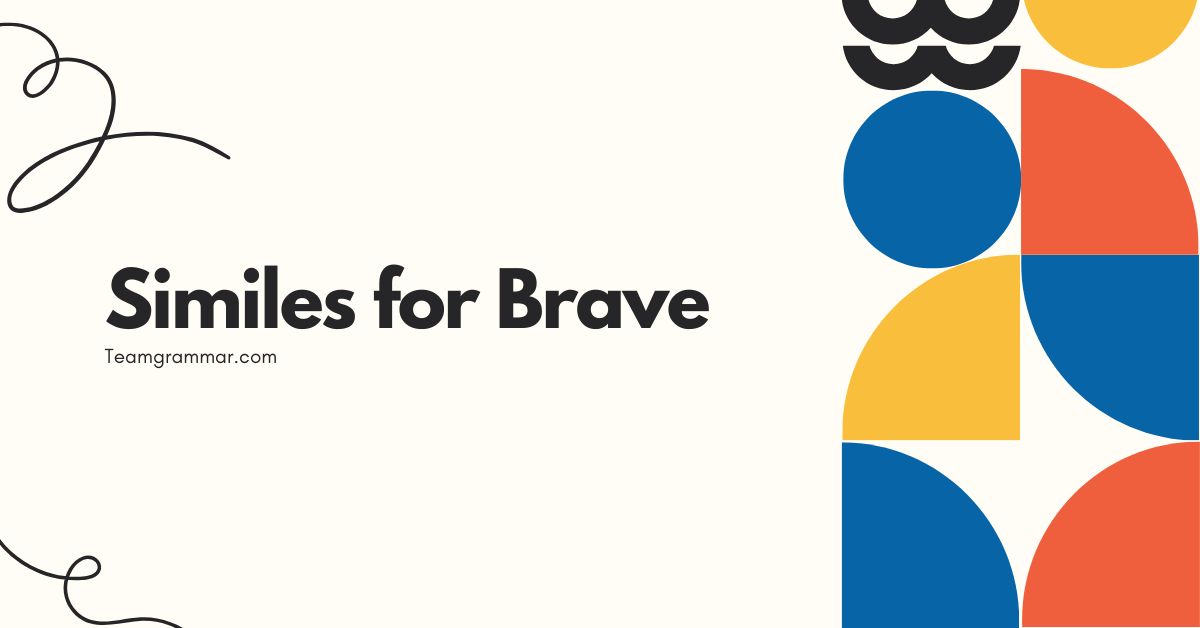37 Similes for Brave: Enhancing Your Descriptive Language
Understanding and using similes effectively is crucial for enriching your descriptive language and making your writing more vivid and engaging. Similes allow you to draw comparisons between seemingly unrelated things, highlighting specific qualities and creating powerful imagery.
This skill is particularly valuable when describing abstract concepts like bravery, where a direct definition might fall short of capturing its true essence. Mastering similes not only improves your writing style but also enhances your ability to communicate complex ideas with clarity and impact.
This guide will benefit students, writers, and anyone looking to refine their language skills and express themselves more creatively.
Table of Contents
- Introduction
- Definition of Simile
- Structural Breakdown of Similes
- Types of Similes
- Examples of Similes for Brave
- Usage Rules for Similes
- Common Mistakes with Similes
- Practice Exercises
- Advanced Topics in Similes
- Frequently Asked Questions
- Conclusion
Definition of Simile
A simile is a figure of speech that compares two unlike things, using the words “like” or “as.” The purpose of a simile is to create a vivid image or to emphasize a particular quality by associating it with something more familiar or concrete. Unlike metaphors, which directly state that one thing is another, similes suggest a resemblance or similarity.
Classification and Function
Similes belong to the broader category of figurative language, which includes metaphors, personification, and hyperbole. Their primary function is descriptive, adding depth and color to writing.
By drawing a comparison, similes can make abstract ideas more understandable and relatable. They are commonly used in literature, poetry, and everyday conversation to enhance expression and create impact.
Contexts for Using Similes
Similes are appropriate in various contexts, from creative writing and poetry to persuasive speeches and casual conversations. In literature, they help authors paint vivid pictures and evoke emotions.
In persuasive writing, similes can make arguments more compelling by drawing parallels that resonate with the audience. Even in everyday speech, similes can add flair and clarity to your communication.
The key is to use them judiciously and ensure that the comparison is both meaningful and effective.
Structural Breakdown of Similes
The basic structure of a simile involves three key components: the subject being described, the word “like” or “as,” and the object or concept to which the subject is being compared. Understanding this structure is essential for creating effective and meaningful similes.
The Subject
The subject is the person, place, thing, or idea being described. It is the focal point of the simile and the element whose qualities are being highlighted.
For example, in the simile “He was as brave as a lion,” the subject is “He.”
The Connector: “Like” or “As”
The words “like” and “as” serve as the connectors that establish the comparison between the subject and the object. “Like” indicates a resemblance, while “as” implies a degree of equality in the specified quality.
The choice between “like” and “as” often depends on the specific nuance you want to convey.
The Object of Comparison
The object of comparison is the person, place, thing, or idea to which the subject is being compared. This object should possess a quality that you want to associate with the subject.
In the example “He was as brave as a lion,” the object of comparison is “a lion,” which is known for its bravery.
Examples of Structural Elements
Consider these examples to illustrate the structural elements of similes:
- Subject: Her courage Connector: was like Object: a shield against fear.
- Subject: His bravery Connector: as Object: unwavering as a mountain.
- Subject: The soldier’s heart Connector: was like Object: a forge, tempered by battle.
Types of Similes
Similes can be categorized based on the type of comparison they make and the effect they create. Understanding these different types can help you choose the most appropriate simile for your intended purpose.
Descriptive Similes
Descriptive similes focus on physical attributes or observable qualities. They aim to create a vivid image in the reader’s mind by comparing the subject to something with similar characteristics.
For instance, “His bravery was as bright as the morning sun” uses the brightness of the sun to describe the intensity of his bravery.
Emotional Similes
Emotional similes evoke feelings or emotional states. They compare the subject’s emotions to something that elicits a similar emotional response in the reader.
For example, “Her bravery felt like a warm embrace in a cold world” connects the feeling of bravery to the comforting sensation of a warm embrace.
Abstract Similes
Abstract similes compare abstract concepts or ideas. They help to make complex or intangible notions more understandable by relating them to something more concrete.
For example, “Bravery is like a muscle; the more you use it, the stronger it gets” compares bravery to a muscle, making it easier to grasp the idea that bravery can be developed over time.
Action-Oriented Similes
Action-oriented similes describe actions or behaviors by comparing them to other actions or behaviors. They often use verbs to emphasize the similarity between the two.
For example, “He faced the challenge like a warrior charging into battle” compares his act of facing a challenge to the action of a warrior charging.
Examples of Similes for Brave
Here are several examples of similes that can be used to describe bravery, categorized for clarity. These examples will help you understand how to use similes effectively to convey the concept of bravery in various contexts.
General Similes for Brave
These similes capture the essence of bravery in a general sense, suitable for a wide range of situations.
| Simile | Explanation |
|---|---|
| As brave as a lion | Compares bravery to the courage and strength associated with a lion. |
| Like a knight in shining armor, he was brave. | Evokes the image of a fearless knight ready to defend. |
| Her bravery was like a beacon in the darkness. | Suggests that her bravery provided guidance and hope in a difficult situation. |
| He stood his ground as brave as an oak tree in a storm. | Implies steadfastness and resilience in the face of adversity. |
| She faced her fears like a soldier facing the enemy. | Highlights the determination and resolve required to confront fear. |
| His heart was as brave as a roaring fire. | Conveys the intensity and passion behind his bravery. |
| Her spirit was like a fearless bird soaring through the storm. | Suggests that her bravery allowed her to overcome obstacles and rise above adversity. |
| He faced the challenge like a captain steering his ship through a storm. | Highlights his leadership and courage in navigating difficult situations. |
| Her courage was like a shield, protecting her from harm. | Suggests that her bravery provided a defense against negativity and danger. |
| He stood tall as brave as a mountain. | Implies steadfastness and resilience in the face of adversity. |
| She faced her fears like a marathon runner approaching the finish line. | Highlights the determination and resolve required to confront fear. |
| His heart was as brave as a roaring waterfall. | Conveys the intensity and passion behind his bravery. |
| Her spirit was like a fearless eagle soaring through the sky. | Suggests that her bravery allowed her to overcome obstacles and rise above adversity. |
| He faced the challenge like a general planning a strategy. | Highlights his leadership and courage in navigating difficult situations. |
| Her courage was like a fortress, protecting her from harm. | Suggests that her bravery provided a defense against negativity and danger. |
| As brave as a firefighter rushing into a burning building. | Highlights the courage and selflessness required to confront danger. |
| Like a surgeon performing a risky operation, he was brave. | Evokes the image of a skilled professional facing a high-stakes situation with courage. |
| Her bravery was like a lighthouse guiding ships through treacherous waters. | Suggests that her bravery provided guidance and hope in a difficult situation. |
| He stood his ground as brave as a rock in a hurricane. | Implies steadfastness and resilience in the face of adversity. |
| She faced her fears like a tightrope walker crossing a chasm. | Highlights the determination and resolve required to confront fear. |
Similes Describing Inner Strength
These similes emphasize the inner fortitude and resilience associated with bravery.
| Simile | Explanation |
|---|---|
| Her inner strength was like a wellspring, never running dry. | Suggests that her bravery was fueled by an inexhaustible source of inner power. |
| His spirit shone as brave as a diamond in the rough. | Highlights the inherent value and resilience of his inner strength. |
| Her resolve was like steel, unyielding in the face of pressure. | Emphasizes the firmness and determination of her inner strength. |
| He faced his demons like a warrior confronting his adversaries within. | Highlights the internal battle and courage required to overcome personal challenges. |
| Her heart was as brave as a compass, always pointing true north. | Suggests that her bravery was guided by a strong moral compass and unwavering principles. |
| His courage was like a deep-rooted tree, weathering any storm. | Implies that his inner strength was deeply embedded and capable of withstanding adversity. |
| Her inner strength was like a fortress, protecting her from despair. | Suggests that her bravery provided a defense against negativity and emotional pain. |
| His spirit shone as brave as a star in the darkest night. | Highlights the inherent value and resilience of his inner strength. |
| Her resolve was like granite, unyielding to pressure. | Emphasizes the firmness and determination of her inner strength. |
| He faced his demons like a knight confronting a dragon. | Highlights the internal battle and courage required to overcome personal challenges. |
| Her heart was as brave as a guiding star, always leading the way. | Suggests that her bravery was guided by a strong moral compass and unwavering principles. |
| His courage was like a sturdy bridge, connecting him to success. | Implies that his inner strength was deeply embedded and capable of withstanding adversity. |
| Her inner strength was like a river, flowing and unwavering. | Suggests that her bravery was fueled by an inexhaustible source of inner power. |
| His spirit shone as brave as a candle in the dark. | Highlights the inherent value and resilience of his inner strength. |
| Her resolve was like the roots of a tree, unyielding in the face of storms. | Emphasizes the firmness and determination of her inner strength. |
| He faced his demons like a sailor navigating treacherous waters. | Highlights the internal battle and courage required to overcome personal challenges. |
| Her heart was as brave as a beacon, always shining bright. | Suggests that her bravery was guided by a strong moral compass and unwavering principles. |
| His courage was like the sun, always shining through the clouds. | Implies that his inner strength was deeply embedded and capable of withstanding adversity. |
| Her inner strength was like a phoenix, rising from the ashes. | Suggests that her bravery was fueled by an inexhaustible source of inner power. |
| His spirit shone as brave as a light in the darkness. | Highlights the inherent value and resilience of his inner strength. |
Similes Highlighting Fearlessness
These similes focus on the absence of fear and the ability to act despite potential danger.
| Simile | Explanation |
|---|---|
| He faced the unknown like a fearless explorer charting new territory. | Highlights his willingness to venture into unfamiliar situations without hesitation. |
| Her bravery was like a shield, deflecting all doubts and insecurities. | Suggests that her fearlessness protected her from negative thoughts and self-doubt. |
| He charged into battle as fearless as a storm. | Emphasizes the raw power and unwavering determination behind his fearlessness. |
| She spoke her mind as brave as a lone voice in a crowd. | Highlights her courage to express her opinions even when facing opposition. |
| He confronted the challenge like a fearless climber scaling a mountain. | Suggests that his fearlessness allowed him to overcome obstacles and reach new heights. |
| Her resolve was as fearless as a tightrope walker above a chasm. | Emphasizes the unwavering focus and determination required to act without fear. |
| He faced the unknown like a fearless astronaut embarking on a space mission. | Highlights his willingness to venture into unfamiliar situations without hesitation. |
| Her bravery was like an impenetrable wall, deflecting all doubts and insecurities. | Suggests that her fearlessness protected her from negative thoughts and self-doubt. |
| He charged into battle as fearless as a speeding train. | Emphasizes the raw power and unwavering determination behind his fearlessness. |
| She spoke her mind as brave as a lioness protecting her cubs. | Highlights her courage to express her opinions even when facing opposition. |
| He confronted the challenge like a fearless warrior charging into battle. | Suggests that his fearlessness allowed him to overcome obstacles and reach new heights. |
| Her resolve was as fearless as a rock in a hurricane. | Emphasizes the unwavering focus and determination required to act without fear. |
| He faced the unknown like a fearless diver exploring the ocean depths. | Highlights his willingness to venture into unfamiliar situations without hesitation. |
| Her bravery was like a fortress, deflecting all doubts and insecurities. | Suggests that her fearlessness protected her from negative thoughts and self-doubt. |
| He charged into battle as fearless as a whirlwind. | Emphasizes the raw power and unwavering determination behind his fearlessness. |
| She spoke her mind as brave as a lone voice in the wilderness. | Highlights her courage to express her opinions even when facing opposition. |
| He confronted the challenge like a fearless pilot navigating through turbulence. | Suggests that his fearlessness allowed him to overcome obstacles and reach new heights. |
| Her resolve was as fearless as a mountain standing tall. | Emphasizes the unwavering focus and determination required to act without fear. |
| He faced the unknown like a fearless artist creating a masterpiece. | Highlights his willingness to venture into unfamiliar situations without hesitation. |
| Her bravery was like a shield, deflecting all negative energy. | Suggests that her fearlessness protected her from negative thoughts and self-doubt. |
Usage Rules for Similes
While similes are a powerful tool for descriptive writing, it’s important to use them correctly to avoid clichés and ensure clarity. Here are some key rules to follow when using similes.
Avoid Clichés
A cliché is an overused expression that has lost its original impact. Common similes like “as brave as a lion” can be effective, but they are often considered clichés.
To avoid clichés, try to create original and imaginative comparisons that are specific to the context.
Ensure Clarity
The comparison in a simile should be clear and easily understood. Avoid using obscure or unfamiliar objects of comparison that might confuse the reader.
The connection between the subject and the object should be evident and meaningful.
Maintain Consistency
Ensure that the simile is consistent with the tone and style of your writing. A simile that is too humorous or informal might be out of place in a serious or formal context.
Choose similes that align with the overall mood and purpose of your writing.
Use Sparingly
While similes can enhance your writing, overuse can make it seem contrived and distracting. Use similes judiciously and only when they add significant value to your description.
A well-placed simile can be more effective than several mediocre ones.
Examples of Correct and Incorrect Usage
Consider these examples to illustrate the proper and improper use of similes:
- Correct: His bravery was like a roaring waterfall, powerful and unstoppable.
- Incorrect: His bravery was like a box of chocolates. (The comparison is unclear and lacks a meaningful connection.)
- Correct: She stood her ground as brave as an oak tree in a storm, unyielding and resilient.
- Incorrect: She was as brave as a mouse. (This simile is contradictory, as mice are typically associated with fear.)
Common Mistakes with Similes
Even experienced writers can make mistakes when using similes. Being aware of these common errors can help you avoid them and improve your writing.
Mixing Metaphors and Similes
One common mistake is confusing similes with metaphors. Remember that similes use “like” or “as” to make a comparison, while metaphors directly equate two things.
Mixing the two can create confusing and grammatically incorrect sentences.
Using Illogical Comparisons
The comparison in a simile should be logical and meaningful. Avoid making comparisons that don’t make sense or that create a nonsensical image.
The connection between the subject and the object should be clear and relevant.
Overusing Similes
While similes can be effective, overuse can make your writing seem forced and unnatural. Use similes sparingly and only when they add significant value to your description.
Too many similes can overwhelm the reader and detract from the overall impact of your writing.
Incorrect Grammar
Pay attention to grammar when constructing similes. Ensure that the sentence structure is correct and that the words “like” or “as” are used appropriately.
Incorrect grammar can make your simile sound awkward and unprofessional.
Examples of Common Mistakes
Here are some examples of common mistakes with similes, along with corrections:
| Incorrect | Correct | Explanation |
|---|---|---|
| He was bravery embodied, like a lion. | He was as brave as a lion. | Mixing a metaphor (“bravery embodied”) with a simile. |
| Her courage was like a refrigerator. | Her courage was like a warm fire in winter. | Illogical comparison. |
| The brave man, like a general, as a lion, stood tall, as a tree. | The brave man stood as tall as a tree. | Overusing similes in one sentence. |
| She is brave like him. | She is as brave as him. | Incorrect use of “like” instead of “as” in this context. |
| He fought like a bravely warrior. | He fought like a brave warrior. | Grammatical error: using an adverb instead of an adjective. |
Practice Exercises
Test your understanding of similes with these practice exercises. Fill in the blanks to complete the similes, or rewrite the sentences using a simile to describe bravery.
Exercise 1: Completing Similes
Complete the following similes with appropriate endings.
| Question | Answer |
|---|---|
| 1. His bravery was like __________. | 1. His bravery was like a shield. |
| 2. She faced her fears as brave as __________. | 2. She faced her fears as brave as a lion. |
| 3. He stood his ground like __________. | 3. He stood his ground like a rock in a storm. |
| 4. Her courage was as unwavering as __________. | 4. Her courage was as unwavering as a mountain. |
| 5. His heart was as brave as __________. | 5. His heart was as brave as a roaring fire. |
| 6. Their bravery shone like __________. | 6. Their bravery shone like a beacon in the night. |
| 7. He acted as fearless as __________. | 7. He acted as fearless as an explorer. |
| 8. Her spirit was like __________, brave and free. | 8. Her spirit was like a bird, brave and free. |
| 9. His resolve was as strong as __________. | 9. His resolve was as strong as steel. |
| 10. She faced the challenge like __________. | 10. She faced the challenge like a warrior. |
Exercise 2: Rewriting Sentences with Similes
Rewrite the following sentences using a simile to describe bravery.
| Question | Answer |
|---|---|
| 1. He was very brave in the face of danger. | 1. He was as brave as a lion in the face of danger. |
| 2. Her courage did not falter, even when she was afraid. | 2. Her courage was like a shield, not faltering even when she was afraid. |
| 3. He stood firm against the opposition. | 3. He stood firm against the opposition like a rock in the sea. |
| 4. She approached the difficult task without fear. | 4. She approached the difficult task as fearless as a pilot. |
| 5. His bravery inspired everyone around him. | 5. His bravery shone like a beacon, inspiring everyone around him. |
| 6. She confronted the bully without hesitation. | 6. She confronted the bully as fearless as a lioness protecting her cubs. |
| 7. He faced the challenge with unwavering determination. | 7. He faced the challenge with unwavering determination, like a mountain standing tall. |
| 8. Her courage was evident throughout the ordeal. | 8. Her courage was like a guiding star, evident throughout the ordeal. |
| 9. He demonstrated great bravery in rescuing the child. | 9. He demonstrated great bravery in rescuing the child, like a firefighter rushing into a burning building. |
| 10. She spoke her mind despite the potential consequences. | 10. She spoke her mind despite the potential consequences, as brave as a lone voice in a crowd. |
Advanced Topics in Similes
For advanced learners, exploring more complex aspects of similes can further enhance their writing skills. This includes understanding the nuances of simile construction and using similes in creative and unconventional ways.
Extended Similes
An extended simile is a simile that is developed over several lines or even an entire paragraph. It allows you to explore the comparison in greater detail, adding depth and complexity to your description.
Extended similes can be particularly effective in creating vivid imagery and conveying complex ideas.
Implied Similes
An implied simile is a simile in which the word “like” or “as” is omitted. The comparison is suggested indirectly, requiring the reader to infer the connection between the subject and the object.
Implied similes can be more subtle and sophisticated than explicit similes.
Subverting Expectations
One advanced technique is to use similes that subvert expectations. This involves creating a comparison that is unexpected or unconventional, challenging the reader’s assumptions and creating a memorable effect.
Subverting expectations can add humor, irony, or surprise to your writing.
Frequently Asked Questions
Here are some frequently asked questions about similes, along with detailed answers to help you deepen your understanding.
- What is the difference between a simile and a metaphor?
- Can a simile be a cliché?
- How do I choose the right object of comparison for a simile?
- Is it okay to use multiple similes in one paragraph?
- What if I can’t think of a good simile?
- How can I improve my simile-writing skills?
- Are similes only used in writing?
- What makes a simile effective?
- Can similes be subjective?
- How do I know if I’m overusing similes in my writing?
A simile compares two things using “like” or “as,” while a metaphor directly equates them without using these words. For example, “He is as brave as a lion” (simile) versus “He is a lion” (metaphor).
Yes, similes can become clichés if they are overused and lack originality. To avoid this, strive to create fresh and imaginative comparisons that are specific to the context.
Choose an object that has a clear and meaningful connection to the subject you are describing. The comparison should highlight a specific quality or characteristic that you want to emphasize.
Yes, but use them sparingly. Overusing similes can make your writing seem contrived and distracting.
A well-placed simile is more effective than several mediocre ones.
Don’t force it. Sometimes, a direct description is more effective than a weak or illogical simile.
Focus on conveying your message clearly and concisely.
Practice writing similes regularly and read widely to see how other writers use them effectively. Pay attention to the comparisons you encounter in literature and everyday conversation.
No, similes are also used in spoken language to add emphasis and clarity to your communication. They can make your speech more vivid and engaging.
An effective simile is clear, original, and meaningful. It should create a vivid image in the reader’s mind and enhance their understanding of the subject being described.
Yes, similes can be subjective to some extent, as the effectiveness of a comparison can depend on the reader’s individual experiences and associations. However, a good simile should still be grounded in a logical and recognizable connection.
If your writing feels cluttered or if the similes start to distract from your main points, you may be overusing them. Try to cut back and focus on using only the most effective and impactful similes.
Conclusion
Mastering the art of using similes is a valuable skill for anyone looking to enhance their descriptive language and communicate more effectively. By understanding the structure, types, and usage rules of similes, you can create vivid and memorable comparisons that add depth and color to your writing.
Remember to avoid clichés, ensure clarity, and use similes judiciously to achieve the greatest impact. With practice and attention to detail, you can harness the power of similes to express complex ideas and evoke emotions in your readers.
As you continue to develop your writing skills, experiment with different types of similes and explore unconventional comparisons. Pay attention to how other writers use similes effectively and learn from their techniques.
By continually refining your understanding and application of similes, you can elevate your writing to new heights and communicate with greater clarity and impact. Embrace the challenge and enjoy the creative possibilities that similes offer.







